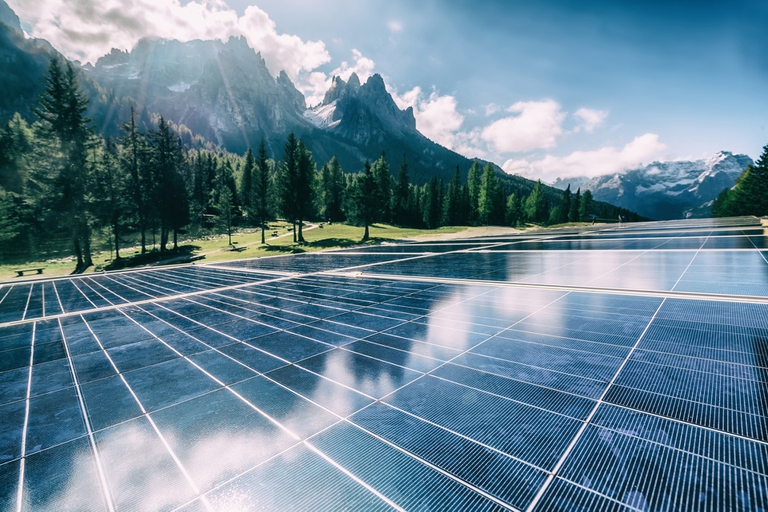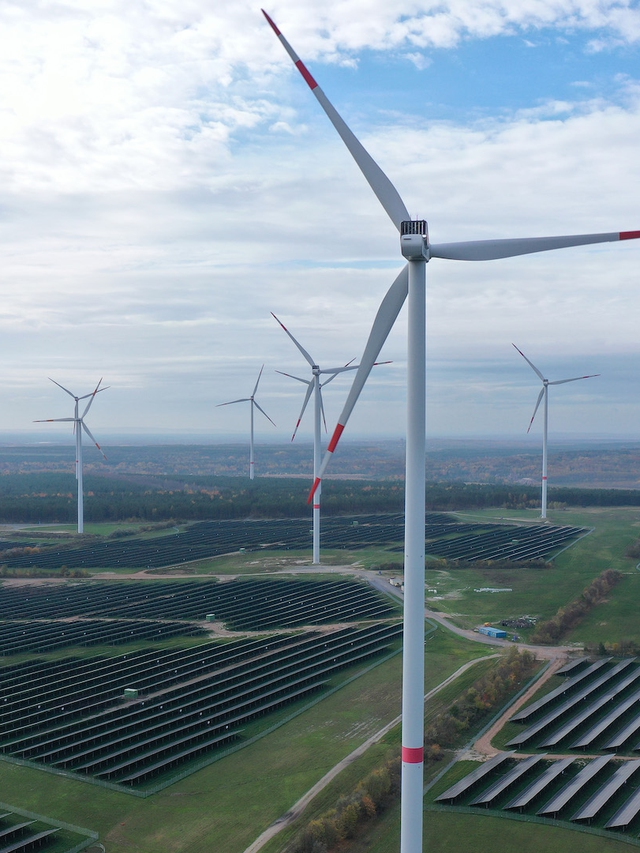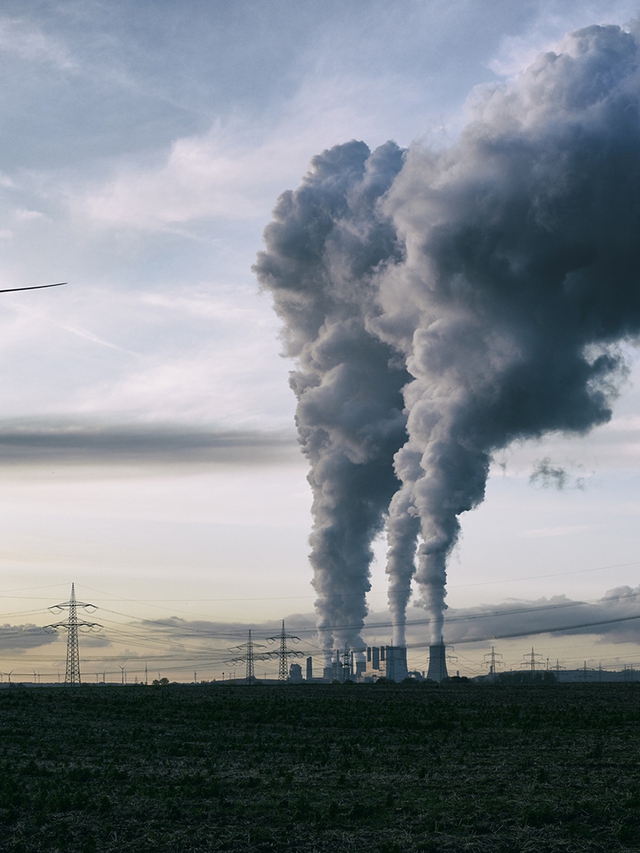https://www.lifegate.it/idrogeno-verde-transizione-energetica
- |
Interest in the potential of hydrogen is now high, but it seems that its use is particularly favored by the historical moment.The political, institutional and industrial will to accelerate the transition to more sustainable economies attentive to the use and consumption of resources, the impact on the environment and on people.
Hydrogen is a carrier, not a source of energy.This means that it is not present in nature, unless linked to other elements such as water, but must be produced by other energy sources.To better understand how it can play a truly strategic role in the decarbonisation of our societies, we need to understand how hydrogen can be produced and what its uses can be.
- How hydrogen is produced
- Why the European Union is focusing on hydrogen
- Green hydrogen, 3 phases for growth
- The applications of hydrogen
- Transport and accumulation
- How much does green hydrogen cost
- How to stimulate the demand for hydrogen
- Guarantee of origin of renewable hydrogen
- Green hydrogen in the Pnrr
How hydrogen is produced
Hydrogen can be produced in many ways and each corresponds to a different share of emissions.Below is a useful vocabulary:
- Hydrogen produced with electricity or low carbon (electricity based hydrogen or low carbon hydrogen):in this case hydrogen is obtained from water through electrolysis using electricity, now produced mostly from fossil fuels.This process takes place in the presence of very high temperatures, we are talking about hundreds of degrees, and energy consumption is consequently very high.Low carbon hydrogen is also obtained through biogas reforming, i.e. when a gaseous mixture of carbon monoxide and hydrogen is obtained from the transformation of a hydrocarbon with a high calorific value.Finally, through the biochemical conversion of biomass.
- If the energy is produced from renewable sources we speak of renewable hydrogen or green hydrogen (renewable hydrogen or clean hydrogen).In the latter case, greenhouse gas emissions are close to zero.
- Hydrogen produced from waste (circular hydrogen):produced by the synergy between the sector dedicated to waste management and disposal and that of the chemical industry, circular hydrogen is one of the forms of low carbon hydrogen.Through waste to chemicals technology, a process of partial oxidation of non-recyclable waste, it is possible to obtain a synthesis gas, also called circular gas.The latter can be used as a basis for producing hydrogen, defined as "circular" as it is obtained from the chemical conversion of post-consumer materials which are thus recovered, while at the same time avoiding their disposal in landfill or via incineration.
- Hydrogen produced from fossil sources (fossil based hydrogen):indicates the production of hydrogen from fossil fuels, through the reforming of natural gas or the gasification of coal.These are the two most strongly emissive forms of hydrogen, conventionally known, respectively, as gray hydrogen and black hydrogen.
- Hydrogen produced from fossils with carbon capture or low carbon (fossil-based hydrogen with carbon capture or blue hydrogen):if the process described above is combined with a system for capturing up to 90 percent of carbon, a form of hydrogen is obtained that is less emissive than gray hydrogen, but not as virtuous as green hydrogen.Electric blue hydrogen production technologies are available in the market.Their architecture is similar to that of traditional steam reforming, to which however the use of electricity is added to power the endothermic reactions of steam methane reforming and a CO2 capture system.
- Synthetic fuels derived from hydrogen (hydrogen-derived synthetic fuels):these are synthetic fuels derived from hydrogen, such as synthetic kerosene for aviation, synthetic diesel for cars or, again, various molecules used in chemistry and fertilizers.
Conventionally, the terms are used green, blue and gray hydrogen to indicate, respectively, the hydrogen produced by renewable energy, with carbon capture and from fossil fuels.

Why the European Union is focusing on hydrogen
This carrier is considered by European Commission a pillar of the sustainable economic restart from COVID-19.Not only that, it is considered a key factor in the energy transition path for compliance with the commitments undertaken in 2015 with the signing of theParis Agreement and the achievement of climate neutrality by 2050, i.e. the balance between carbon emissions and absorption.In the Global Renewable Outlook 2020, Irena estimates that to reach the targets set by the Paris Agreement, 8 percent of the energy consumed on the planet will have to be produced with hydrogen.
Read also:
The European executive launched the European hydrogen strategy.In the document he writes “The time to act is now”, and clarifies why we need hydrogen.First of all, it reveals its nature versatility of use:as raw material, fuel or to store energy.He then explains them application potential:from transport to decentralized energy production through use in industrial processes, such as those with high energy consumption in steel or chemistry, the so-called "hard-to-abate".
The carrier currently covers a small slice of the European energy mix which is mostly produced from fossil fuels, natural gas and coal.According to the estimates contained in theHydrogen roadmap Europe of 2019, drawn up by Fuel cells and hydrogen joint undertaking (Fch Ju), public-private partnership to support research and development activities in the field of fuel cells and hydrogen, the growth of this carrier could create 1 million direct and indirect jobs in Europe by 2050, in the ambitious scenario of a consumption of 665 terawatt hours (TWh).Overall, investments of up to 180-470 billion euros in green hydrogen and up to 3-18 billion in blue hydrogen are expected.To be able to satisfy 24 percent of energy demand over the next thirty years.
With the plan REPowerEU, announced on 8 March 2022 by the European Commission, Europe has further accelerated the production and consumption of green hydrogen in order to achieve energy independence from Russian gas.It has in fact established the objective of 10 million tonnes of European production of renewable hydrogen by 2030 and another 10 million imported from non-European countries, allocating a further 200 million euros for research on the vector.
Green hydrogen, 3 phases for growth
For it to play a truly strategic role in the energy transition path, its production will have to take place via renewable energy.The real objective, therefore, is to increase the production of green hydrogen.To this end, the European executive recommends, it will be necessary to develop large-scale projects, of wide scope, so as to reduce the cost of production and make it more convenient.
To build a dynamic ecosystem, the Commission proposes growth in three phases:
- first phase:install 6 GW of electrolysers by 2024 and produce up to 1 million tons of green hydrogen;
- second phase:install 40 GW of electrolysers by 2030 and produce up to 10 million tons;
- third phase:thanks to the development of large-scale projects, green hydrogen should reach the maturity between 2030 and 2050, at the same time as the massive production of renewable energy.
The applications of hydrogen
To accelerate the research and application of hydrogen technologies, so-called hydrogen valley, a name that recalls that of the famous Silicon Valley.These are geographically delimited areas that will arise all over the world to implement and test an infrastructure dedicated to transport power, residential and industrial heating and grid balancing.As part of the European project Ipcei Hy2Use, a non-repayable contribution of 194 million euros was awarded to the Italian company NextChem for the development of a waste to hydrogen plant.In the initial phase, the production of 1,500 tonnes per year of hydrogen and 55 thousand tonnes per year of ethanol is expected.Hydrogen production will grow according to the evolution of demand, up to 20 thousand tons per year.The project constitutes the hydrogen valley in Rome, which will be the first technological incubator on an industrial scale for the development of the national supply chain for the production, transport, accumulation and use of hydrogen.Circular hydrogen has a competitive cost compared to gray hydrogen, which may encourage its wider adoption.
In the short term, renewable and low carbon hydrogen will be able to find easy application in refineries, in the production plants of ammonia And fertilizers.Among these is the Madoqua project, for which NextChem has been awarded a pre-Feed of engineering services, which involves the production of green ammonia and its transport to Northern Europe.Furthermore, it can also be applied in energy-intensive industries, for example steel or chemical products, in maritime and heavy transport, on rubber or iron, contributing to the reduction of emissions.
For them hydrogen fuel cells we will have to wait, but both the Horizon Europe funding program and the Fuel cell and hydrogen joint undertaking aim to accelerate Europe's technological leadership.
Transport and accumulation
Hydrogen storage can be physical (in pressurized cylinders) or chemical, i.e. by binding hydrogen into liquid and stable chemical compounds that can be transported more easily.Hydrogen can be transported pure or mixed, fit gaseous or liquid, along the gas network or with trucks or ships docking at LNG terminals.Mixing, it should be noted, decreases the value of the hydrogen and also changes the quality of the natural gas consumed.It then risks fragmenting the market if different standards are accepted in the design of the infrastructure and applications for the end user.On the other hand, it is the most convenient solution at the moment:involves the reconversion of the gas infrastructure to be able to distribute, store and supply large volumes of hydrogen, potentially over long distances.
The carrier can be stored to cover peak demand and guarantee secure supply of energy.As well as to give flexibility to the network and favor the so-called sector copulation, i.e. the integration between electricity and gas networks.Designing the infrastructure for the passage of hydrogen will only be possible after analyzing the type of production, demand and transport costs, also in light of the currently ongoing review of the regulation on trans-European energy networks (Ten-E).
How much does green hydrogen cost
To be more widely used, green hydrogen will have to become more convenient.Today it is not:it costs between 2.5 and 5.5 euros per kilo compared to 2 euros per kilo for the blue one and 1.5 euros for the gray one.The values are reported in the report Future of hydrogen of the International Energy Agency (IEA) and are based on an electricity cost of between 35 and 87 euros per megawatt hour (MWh).Figures that reflect the continuation fluctuation in raw material prices with which hydrogen is produced, skyrocketed due to the strong climate of uncertainty dictated by the continuous changes affecting the geo-political and energy scenario.
In any case, one point remains firm:the price of renewable hydrogen will fall if production through electricity increases electrolysers and access to low-cost renewable energy.The community objective is to reach 1.8 euros per kilogram by 2030.Being able to calibrate the investments of private entities will therefore be a priority.Committed in this sense are the 190 CEOs of the same number of world-famous companies that are part of theInternational hydrogen council and the many representatives of institutions, industries, civil societies who join theEuropean Clean Hydrogen Alliance (Clean hydrogen alliance), launched on the same day as the Strategy to implement its objectives.
In the European Union today, around 280 companies, 60 percent of them small and medium-sized enterprises, are working on the production and supply of electrolysers, and more than 1 gigawatt (GW) is in the pipeline.Total European production capacity is currently less than 1 GW per year.The will of European industry is to achieve 40 GW of electrolysers by 2030 in Europe and the same number in the export areas of the EU.To give a practical example, with 1MW of electrolysis 400 kg of green hydrogen is produced in 24 hours and with one kg of hydrogen a car can travel 100 km.
An internal study of the European executive, Hydrogen generation in Europe:Overview of costs and key benefits, explains that by 2030 the construction of electrolysers will have to absorb between 24 and 42 billion euros.These will have to be connected to 80-120 GW of production capacity from wind and solar photovoltaic with a further 220-340 billion euros. 11 billion they will be used for retrofitting, a technical term for adaptation, of plants with carbon capture and storage systems.Others 65 billion they will be intended for transport, distribution and storage of the carrier.The installation of 400 new refueling stations, compared to the approximately 100 existing today, could require resources ranging from 850 and 1,000 million euros.
How to stimulate the demand for hydrogen
The European Commission wants to match the increase in the supply of renewable and low carbon hydrogen with an increase in request.This will require a wide availability of raw materials, in accordance with the Action Plan for Critical Raw Materials (Raw materials action plan) which wants to reduce Europe's dependence on third countries and diversify its supply.And it will require the implementation of the new Action Plan for the circular economy (Circular economy action plan), to stimulate a more circular economic model that respects the environment and human health.
They will therefore be necessary support policies.The executive is considering various options, including the introduction of minimum quotas of renewable hydrogen (including low carbon), or its derivatives, in specific sectors.Or the adoption of a threshold or one common standard on carbon emissions to promote the production of low or zero impact hydrogen.
A supportive political framework will find fertile ground in the European directive on renewables and in theEmission trading system, the Union's emissions trading system.To these are added the 2030 climate target plan, the plan to reduce greenhouse gas emissions by 55 percent compared to pre-industrial levels, and the Industrial policy, the plot of the industrial strategy.Ready to support it there will be the financial instruments of Next generation Eu.
Overall, this complex regulatory structure aims to offer differentiated support, taking into account the type of hydrogen produced, to the technological maturity of the individual member states.Without forgetting to guarantee the interoperability of markets of pure hydrogen, for which cross-border operational rules or common quality standards, regarding purity or thresholds for contaminants, may be needed.
Guarantee of origin of renewable hydrogen
In June 2020 the European Union launched a scheme for certification and the guarantee of origin of hydrogen produced with renewable energy.THE'announcement of the European Energy Commissioner Kadri Simson, during the digital event of last February 12th "Central and Eastern Europe Hydrogen Conference", confirms the commitments made so far.Some of the measures are also expected in June Fit for 55, a package with which Europe aims to reduce greenhouse gas emissions by 55 percent by 2030, among the pillars of European green deal.
Hydrogen in the Pnrr
Almost all Member States have included hydrogen in theirs National energy and climate plan (Pniec), with which they establish energy efficiency objectives, renewable sources and reduction of carbon dioxide emissions.Sharing ideas on the platform is useful in this sense HyNet developed by the Directorate General for Energy of the European executive.
In the National recovery and resilience plan (Pnrr) hydrogen is seen as a key element to help decarbonise hard-to-abate sectors, as sectors characterized by high energy intensity and without scalable electrification options are called.These include the basic chemicals sectors, such as ammonia and methanol, and oil refining, steel and glass.Specifically, hydrogen falls within the Mission 2, Component 2 M2C2 – Renewable energy, hydrogen, network and sustainable mobility, to which the government has allocated a total of 59.46 billion euros.Specifically, the highest resources are intended to promote the use of hydrogen in sectors hard-to-abate (2 billion euros), to the production of hydrogen in abandoned industrial areas (500 million) and the experimentation of hydrogen for the rail transport (300 million).
110 million of the 160 million expected for investment in hydrogen research and development were allocated, in the summer of 2022, by the Ministry of Ecological Transition to Operational research plan (Por).The plan is developed by ENEA, which is entitled to the main portion of the funds (75 million) in collaboration with the CNR and the RSE, and will focus on the entire value chain of the carrier:production, storage, distribution and end uses, to which a different amount of resources will be allocated.By 2025, the expected results on research activities related to the production of hydrogen from renewable sources and grid electricity to reduce the emission of climate-altering gases will be transferred to the Italian industry to push the country's green transition.
For 14 nations, hydrogen is a solution to look at for alternative infrastructure.26 signed the political document Hydrogen Initiative, during the informal meeting of Energy Ministers held in Linz, Austria, already in September 2018.
From 2021 to 2027 they can benefit from the resources put in place with theEuropean regional development fund and the Cohesion fund, which stimulate technology transfer, public-private partnerships and pilot projects to develop innovative solutions in the field of renewables and low-carbon hydrogen.
In conclusion, hydrogen will offer a great opportunity to restore the health of the European Union and forge alliances to diversify and secure energy supplies.Possible partners include Australia, Canada, Norway, South Korea and, above all, North Africa due to its geographical proximity and its rich potential in terms of growth of renewable technologies.Without forgetting the innovation promoted in Japan or in the United States, for example.As hydrogen is a nascent market, the Commission will develop a system for euro hydrogen transactions, thus helping to consolidate the role of the currency in sustainable energy trading.





